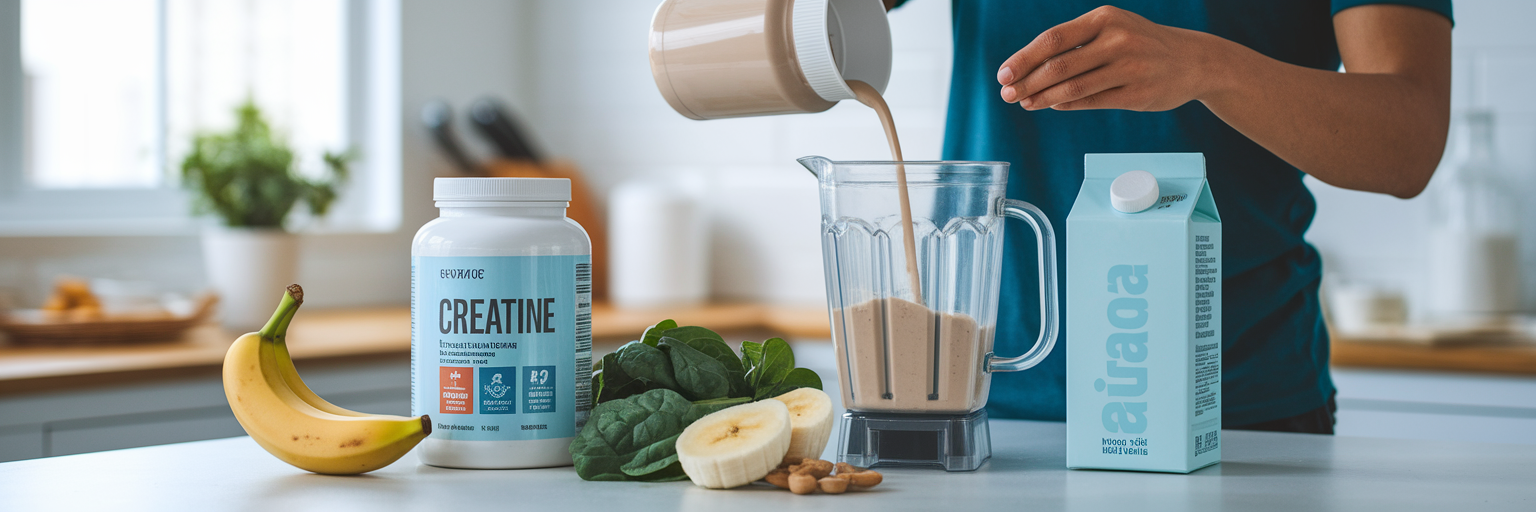Si sigues una dieta basada en plantas, es probable que planifiques tu nutrición con sumo cuidado. Controlas tus macros, te aseguras de obtener suficiente hierro y sabes exactamente de dónde proviene tu B12. Sin embargo, muchos atletas veganos dedicados pasan por alto una de las moléculas más efectivas para el rendimiento: la creatina.
La creatina no es una sustancia extraña ni sintética. Tu cuerpo ya la produce y la utiliza para regenerar el ATP, la fuente de energía directa para movimientos cortos y explosivos. Piénsala como el combustible para esa última repetición pesada, un sprint rápido o un salto potente. Si bien la creatina se encuentra naturalmente en la carne y el pescado, la buena noticia es que el monohidrato de creatina suplementario se produce sintéticamente, lo que lo hace 100% apto para veganos .
Esto es especialmente importante para la creatina en atletas con dietas basadas en plantas . Debido a que las dietas veganas no contienen creatina, tus reservas musculares iniciales son naturalmente más bajas. Esto significa que, al suplementarte, la diferencia en fuerza, potencia y capacidad de entrenamiento puede ser aún más notable. No se trata de corregir una deficiencia, sino de optimizar el sistema energético de tu cuerpo para que esté a la altura de tu arduo trabajo. Para obtener más información sobre sus funciones principales, puedes explorar las numerosas perspectivas que hemos compartido sobre la eficacia de la creatina .
Por qué la creatina es un cambio de juego para el fitness basado en plantas
Muchos atletas que siguen dietas a base de plantas planifican meticulosamente su nutrición, pero podrían pasar por alto una molécula clave para el rendimiento. La creatina no es una sustancia extraña; es algo que tu cuerpo ya utiliza. Si bien se encuentra de forma natural en la carne, el monohidrato de creatina suplementario se produce sintéticamente y es 100% apto para veganos .
Su función principal es sencilla: ayuda a regenerar el ATP, la fuente de energía directa de tu cuerpo para movimientos explosivos como levantar pesas, saltar o correr a toda velocidad. Piénsalo como la reserva de combustible inmediata para tus músculos durante esfuerzos de alta intensidad.
Esto es aún más importante para los veganos. Dado que las dietas basadas en plantas carecen de creatina, sus reservas musculares iniciales suelen ser menores. Por lo tanto, la suplementación puede proporcionar un aumento más notable en la fuerza y la potencia. No se trata de añadir algo artificial, sino de llenar el depósito de energía para apoyar tus objetivos de forma física. Entender lo eficaz que es realmente el monohidrato de creatina puede ayudarte a comprender por qué es un elemento básico para tantos atletas.
Cómo elegir un suplemento de creatina vegano de alta calidad

Cuando empieces a buscar un suplemento, verás diferentes opciones, pero la elección es en realidad bastante sencilla. Debes buscar específicamente monohidrato de creatina . Es la forma más investigada, validada científicamente y rentable disponible. No hay necesidad de complicarse; el original ha resistido la prueba del tiempo por una razón.
La pureza es primordial. Busque productos que hayan sido certificados por terceros por organizaciones como NSF for Sport o Informed-Sport. Esta verificación garantiza que lo que figura en la etiqueta es lo que contiene el frasco, y que está libre de contaminantes o sustancias prohibidas. Es un paso sencillo que le brinda tranquilidad.
También podrías ver el término "micronizado". Esto simplemente significa que el polvo ha sido molido hasta obtener partículas más finas. ¿El beneficio? Se disuelve mucho más fácilmente en líquido. Si alguna vez has tenido que lidiar con un suplemento arenoso que se asienta en el fondo de tu vaso, apreciarás lo mucho mejor que se mezcla un polvo micronizado. Esto también puede ser más suave para el estómago de algunas personas. Para una opción fiable y pura, considera nuestra creatina monohidratada vegana , que está diseñada para facilitar la mezcla y una absorción óptima.
Perfeccionando el tiempo y la dosificación para lograr el máximo impacto.
Una vez que tengas tu creatina, la siguiente pregunta es cómo usarla eficazmente. La buena noticia es que el mejor método también es el más sencillo. Olvida los protocolos complicados; la constancia es lo que realmente importa.
La dosis diaria sencilla: su mejor opción.
Para la gran mayoría de las personas, la estrategia más efectiva y sostenible es tomar de 3 a 5 gramos de monohidrato de creatina al día . Eso es todo. Esta dosis diaria constante es suficiente para saturar completamente los músculos en unas pocas semanas y, lo que es más importante, mantenerlos saturados durante todo el tiempo que se continúe usándola.
¿Qué pasa con la "fase de carga"?
Es posible que hayas oído hablar de una "fase de carga", que consiste en tomar alrededor de 20 gramos al día durante los primeros 5-7 días para saturar los músculos más rápidamente. Si bien esto funciona, no es necesario. La dosis diaria de 3-5 gramos te llevará al mismo punto exacto, solo que un par de semanas después. Mucha gente prefiere el enfoque de mantenimiento diario porque es más sencillo y menos propenso a causar las leves molestias digestivas que a veces pueden acompañar a las dosis más altas.
Cuándo tomar creatina para obtener los mejores resultados
Si bien la constancia es el factor más crítico, existe un periodo óptimo. El mejor momento para tomar creatina parece ser después del entrenamiento. Piensa en tus músculos después de una sesión dura: son como esponjas, preparadas y listas para absorber nutrientes para comenzar el proceso de recuperación y reparación. Tomar creatina durante este periodo puede ayudar a mejorar su absorción.
De hecho, la investigación apoya esta idea. Un estudio destacado por Frontiers in Sports and Active Living sugiere que el consumo de creatina después del ejercicio puede ser más beneficioso para el crecimiento muscular. En los días de descanso, simplemente tómala cuando te sea conveniente para mantener esas reservas musculares.
| Factor | Fase de carga | Dosis diaria de mantenimiento |
|---|---|---|
| Dosis diaria | 20 gramos (divididos en 4 dosis) | 3-5 gramos (dosis única) |
| Duración | 5-7 días, luego cambiar a mantenimiento. | En curso diariamente. |
| Tiempo para saturar los músculos | Aproximadamente 1 semana | ~3-4 semanas |
| Ideal para | Deportistas que necesitan resultados rápidos para una competición. | La mayoría de los usuarios buscan beneficios constantes y sostenibles. |
Nota: Esta tabla compara dos protocolos de dosificación comunes. Para la mayoría de los atletas veganos, la dosis diaria de mantenimiento es más sencilla, más fácil de digerir y, a largo plazo, igual de efectiva.
El combo de poder: Impulsando resultados con proteína vegana

Si quieres maximizar tus resultados, piensa en la creatina y la proteína como la pareja perfecta. La creatina proporciona la "chispa" para tu entrenamiento, dándote la energía para esforzarte más, mientras que la proteína proporciona los "ladrillos" que tu cuerpo necesita para reparar y construir tejido muscular después. Usarlos juntos crea una poderosa sinergia.
La ciencia es sencilla. Consumir creatina con carbohidratos y proteínas puede generar una respuesta insulínica moderada. La insulina actúa como una llave, ayudando a transportar nutrientes como la creatina y los aminoácidos a las células musculares de manera más eficiente. Esto significa que una mayor cantidad de los componentes beneficiosos llega a donde debe ir, justo cuando el cuerpo más lo necesita.
El consejo más práctico para combinar creatina y proteína vegana es simplemente mezclar tu dosis diaria de 3 a 5 gramos de creatina directamente en tu batido de proteína post-entrenamiento. Esto es increíblemente conveniente y asegura que aproveches ese momento óptimo para la absorción de nutrientes. Nuestra deliciosa proteína vegana de chocolate es la compañera perfecta para tu creatina diaria. Para más inspiración, consulta estassencillas recetas de proteína vegana a las que puedes añadir creatina.
La mayoría de las fuentes de proteína veganas funcionan de maravilla. Aquí tienes algunas opciones excelentes:
- Proteína de guisante: Una opción popular e hipoalergénica rica en BCAA.
- Proteína de soja: Una proteína completa que contiene todos los aminoácidos esenciales.
- Proteína de arroz integral: Una excelente opción para personas con sensibilidad a la soja o al guisante.
- Proteína de cáñamo: Ofrece fibra adicional y grasas saludables.
Formas fáciles y creativas de mezclar tu creatina
Una de las mejores cosas del monohidrato de creatina es que prácticamente no tiene sabor ni olor, lo que lo hace increíblemente versátil. No tienes que simplemente tomarlo con agua. Averiguar cómo tomar creatina siendo vegano puede ser tan sencillo como incorporarlo a los alimentos y bebidas que ya disfrutas.
Aquí tienes algunas ideas sencillas y creativas para empezar:
- La forma clásica: Mezcla el producto en un vaso de agua o en tu leche vegetal favorita hasta que se disuelva. Un consejo profesional es que se disuelve un poco más rápido en líquido tibio que en agua helada.
- El batido energético: Este es el método más popular por una razón. Agrega tu dosis diaria directamente a tu batido de proteína vegana post-entrenamiento para obtener una bebida de recuperación completa y práctica.
- El Impulso Matutino: Mézclalo directamente en tu avena diaria, avena de la noche a la mañana o en un tazón de yogur vegano. Como no tiene sabor, ni siquiera notarás que está ahí.
- El tentempié sigiloso: Ponte creativo e incorpóralo a la masa de panqueques o magdalenas veganas antes de cocinar. Es una forma sencilla de obtener tu creatina junto con una comida.
No importa cómo lo tomes, recuerda un consejo crucial: mantente hidratado . La creatina ayuda a llevar agua a las células musculares, así que asegúrate de beber mucha agua durante todo el día para apoyar este proceso y tu salud en general.
Comprender y controlar los posibles efectos secundarios
Es inteligente estar informado sobre cualquier suplemento que tomes. En lo que respecta a los efectos secundarios de la creatina, ya sea en veganos o no, las preocupaciones a menudo se basan en mitos. La creatina es uno de los suplementos más estudiados y seguros del mercado para individuos sanos.
El efecto secundario más comentado es la retención de agua. Es importante entender que la creatina atrae agua hacia las células musculares (intramuscularmente). ¡Esto es en realidad una señal de que está funcionando! Contribuye a una apariencia muscular más llena e hidratada, no al tipo de hinchazón bajo la piel que la gente suele temer. Algunas personas pueden experimentar molestias estomacales leves y temporales o hinchazón, especialmente durante una fase de carga.
Si experimenta alguna molestia, generalmente es fácil de controlar. Aquí tiene algunas estrategias sencillas:
- Mantente hidratado: Este es el consejo más importante. Beber abundante agua durante el día ayuda a tu cuerpo a procesar la creatina y puede mitigar la mayoría de los efectos secundarios menores.
- Prueba la versión micronizada: Si sufres malestar estomacal, cambiar a una versión micronizada puede ayudarte, ya que se disuelve más fácilmente.
- Divide tu dosis: En lugar de tomar 5 gramos de una sola vez, intenta tomar 2,5 gramos por la mañana y 2,5 gramos por la noche.
- Tomar con alimentos: Consumir la creatina con una comida a veces puede amortiguar cualquier posible molestia estomacal.
En última instancia, escucha a tu cuerpo y adáptate según sea necesario. Para la mayoría de las personas, la creatina es una adición sencilla y muy beneficiosa a su rutina de ejercicios. Si tienes más preguntas, puedes encontrar respuestas en nuestra página de preguntas frecuentes .



